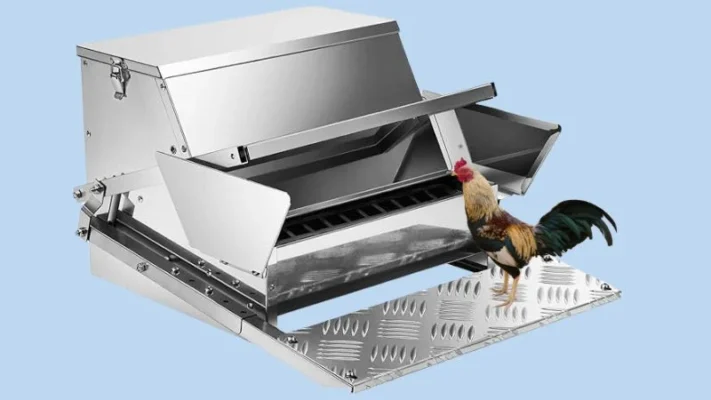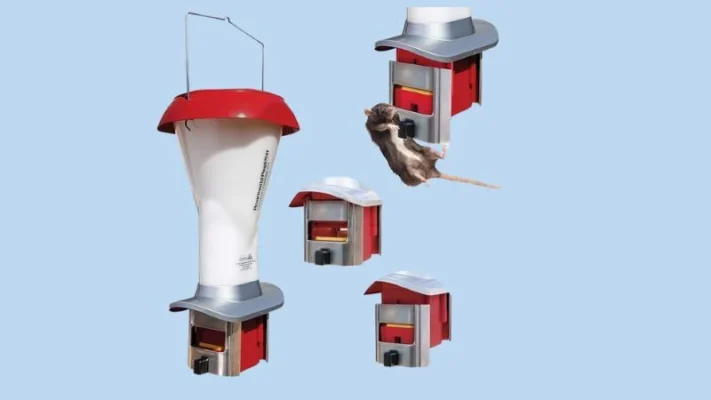I. Introduction
There was a time when I had to wake up at the crack of dawn—not because my hens were hungry, but because the rats had already helped themselves to their dinner. Every night, they’d sneak into the coop, raid the feeder, and leave behind a mess. I tried it all: traps, glue boards, poison. Nothing worked long term. Rebuilding the entire coop felt like overkill.
Then I found a better solution—simpler, cleaner, and surprisingly effective: a rat proof chicken feeder.
If rats are raiding your feeder too, this guide will help you:
✅ Understand how rodent-proof chicken feeders work
✅ Compare top-rated feeder types available in the U.S.
✅ Choose the best one for your flock and your budget
Let’s dive in—because your hens deserve to eat in peace!

II. Planning to Raise Chickens? You’re Right on Time.
Here’s something I always believe—maybe it’s me overthinking things—but I’ve found that most problems are easier to handle if you plan properly from the start.
Raising chickens isn’t just about buying a few chicks, throwing together a coop, and tossing in some feed every day. If you’re in this for the long run—especially backyard chicken keeping—then how you build your setup on Day One can determine 80% of your success and sanity down the road. One thing new chicken keepers often forget? Rodent control. Mice and rats are the #1 enemy of chicks, eggs, and your patience.

👉 Here’s how to build a rodent-resistant setup from the ground up:
• Pick a dry, open spot: Avoid placing your coop near woodpiles, leaf litter, thick bushes, or shady corners. These are perfect hiding places for rodents.
• Raise your coop at least 1–2 ft off the ground: Not only does it help with drainage, but it also makes it harder for rats to dig in.
• Bury hardware cloth around the run: Use fine mesh wire, and bury it at least 1 foot deep along the perimeter to stop rats from tunneling in.
• Seal all gaps: Inside the coop, any opening bigger than ½ inch is fair game for rats. Check door frames, vents, and where panels meet.
• Avoid building under tree branches: Rats are excellent climbers—they can drop right in like paratroopers.
III. Already Have Rats in Your Coop? Don’t Panic—Here’s What to Do
If you’ve seen signs of rats—like droppings, chewed feed bags, or just a gut feeling—take a breath. There are real, effective ways to handle this.
Start by following these steps one at a time:
🧱 Step 1: Find and Block Their Entry Points
Rats don’t appear by magic—there’s always a way in: cracks, holes, or underground tunnels.
👉 Here’s how to check:
• Use a flashlight at night—rats are most active then.
• Inspect under the floor, coop corners, and where walls meet the roof.
• Seal every opening larger than ½ inch using fine hardware cloth or sheet metal.
• For dirt floors: if you spot tunnels, bury fine mesh at least 1 ft deep around the coop or run area.
👉 Expand your search beyond the coop:
Rodents often nest just outside the chicken area—under bushes, tree roots, or wood piles.
If you spot a rat hole (usually a small round opening with loose soil nearby), try this:
1. Burn natural materials like paper or dry grass to create smoke.
2. Channel the smoke into the burrow using a pipe or fan.
3. Surround the hole with fine mesh wire to trap fleeing rats.
4. If smoke escapes from other holes—those are tunnel exits. Mesh those too.
After a few minutes, rats will be forced out by the smoke—and if you’ve surrounded the area well, you’ll catch them without using traps or poison.
💡 Tip: Do this early in the morning or late afternoon—times when rats are likely to be home.
👉 Combine with Safe Traps for Chickens
• Use non-toxic, glue-free traps that are safe for chickens, pets, and kids.
• Place traps in common rat paths: near coop legs, trees, or entry points.
• Bait ideas: peanut butter, grains, egg shells with yolk, or a bit of chicken feed.
• Check traps every morning so rats don’t die and stink up the area.
❓Still can’t get rid of them entirely? Don’t worry—there’s one more fix.
I get it—not everyone builds a “fortress-style” coop. Some of us use reclaimed wood or open-style coops to blend into nature.
Or maybe you’ve sealed most gaps, but the yard’s too big, with too many hiding spots for complete control.
No problem. In these situations, the best move is to cut off the food supply—so rats stop coming around.

🍽️ Step 2: Eliminate the Attraction—Take Away the Food
Rats don’t come around just to hear your rooster crow. They want food. If there’s none, they’ll move on.
So even if you can’t fully rat-proof your coop, you can still make it unattractive:
• Feed the right amount daily—don’t let leftovers sit overnight.
• Clean up feeders at dusk, especially spilled bits—just a little is enough for a whole rat family to throw a party.
• Store feed in sealed containers—buckets with lids, metal bins, or heavy-duty totes. Never leave open bags on the floor.
And the most important part:
👉 Use a rat-proof chicken feeder.
IV. Rat Proof Chicken Feeders – How They Work & Which Type Is Best
Rat-proof chicken feeders are designed with one goal in mind: let your chickens eat, but keep the rats out. Sounds simple, right? But in reality, outsmarting a clever, nimble, and persistent pest like a rat is anything but easy.
So how do these feeders actually work?
They rely on key differences between chickens and rats—like weight, size, and behavior patterns—to activate a lid mechanism, restrict access, or otherwise make it nearly impossible for rats to get to the feed.
After testing several types, I found that three designs consistently perform best when it comes to keeping rats at bay:
1. Treadle Feeders

This is the most common rat-proof design. It features a pedal at the front—when a chicken steps on it with enough weight, the lid opens, allowing access to the feed. Once the chicken steps off, the lid closes automatically. These feeders come in different sizes depending on your flock size.
Pros:
• Allows multiple chickens (including chicks) to eat at once.
• Keeps feed protected from rain and pests.
Cons:
• Requires some initial training. You’ll need to start with the lid open so chickens associate the feeder with food, then gradually switch to the closed mode. After a few tries, most birds learn quickly.
• One thing to watch for: if a chick is inside eating and the older bird steps off the treadle, the lid may close—something to be mindful of during the training phase.
👉 Check price, reviews, and video demo on Amazon: RYFT Automatic Chicken Feeder 25 lb
2. Spring-Loaded Lid Feeders

These feeders use a spring-loaded lid. The chicken pecks or pushes up the lid with its beak or head to access the food. Rats typically don’t have the strength—or the smarts—to do the same. When the chicken stops pushing, the lid snaps shut.
These are usually mounted on a wall or secured at a height that matches chicken height, and they typically hold about 15 lbs of feed—ideal for smaller flocks.
Pros:
• Suitable for chicks if you adjust the feeder height properly.
• Chicks can also sneak a bite when their mother lifts the lid.
• Minimal training needed—just show your birds a few times and they’ll figure it out.
👉 Check price, reviews, and video demo on Amazon: Hanging Automatic Chicken Feeder
3. Deep or Tall-Opening Feeders

This design works on a simple principle: chickens have longer necks and stronger beaks than rats. The feeder’s opening is elevated or deeply inset, so only a chicken can stretch in and reach the food.
These feeders come in two main setups:
• Ground-based models with anti-climb designs and larger capacity (up to 85 lbs).
• Hanging models, typically smaller (around 10 lbs), suspended at a height rats can’t reach.

Pros:
• No training required.
• Keeps feed dry and out of reach from rodents.
Cons:
• Not ideal for chicks, who usually can’t reach inside. You’ll need to provide separate feed or let them follow the mother hen until they grow into it.
👉 Ground version See on Amazon: Metal Chicken Feeder Large Capacity 85lbs
👉 Hanging version See on Amazon:Roamwild Rat Proof Chicken Feeder kit
4. Quick Comparison Table: Rat-Proof Chicken Feeders
| Criteria | Treadle Feeder | Spring-Loaded Lid Feeder | High-Opening Feeder |
| How It Works | Chicken steps to open the lid | Chicken pecks or pushes the lid open | Chicken reaches neck through opening; rats can’t reach |
| Chick-Friendly | Yes, with proper training | Yes, if height is adjusted | No – feed separately or with hen |
| Training Required | Yes, but simple | Yes, but simple | Not needed |
| Common Capacity | 20–50 lb | 10–15 lb | Ground model: up to 85 lb – Hanging model: ~10 lb |
| Installation | Floor-mounted | Wall-mounted or fixed hanging | Ground-placed or hanging, depending on model |
| Rat Resistance | ⭐⭐⭐⭐☆ | ⭐⭐⭐⭐☆ | ⭐⭐⭐⭐⭐ |
| Estimated Price (Amazon) | ~$50–190 | ~$30–80 | ~$50–150, depending on type |
🔍 Key Advantages
• Treadle Feeder: Durable, supports multiple chickens feeding at once
• Spring-Loaded Lid Feeder: Compact, great for tight coop spaces
• High-Opening Feeder: No training needed, rats have a hard time reaching in
Why we rated treadle and spring-lid feeders only 4 out of 5 in rat resistance:
It’s not so much a flaw in the feeder design, but more about chicken behavior and how persistent rats can be. For treadle feeders, rats sometimes sneak in while chickens are feeding or scavenge spilled feed. With spring-loaded lids, if the feeder is mounted too low or malfunctions, or if chickens leave feed behind, rats might still find a way to access it.
👉 To learn more about choosing the right chicken feeder based on your flock size, coop conditions, and feeding habits, check out our in-depth guide: How to Choose the Right Feeder for Your Backyard Flock.
V. Why You Still Need to Clean the Feeder Every Night – Even with a Rat-Proof Model
If rat-proof feeders work so well, why do I still recommend measuring feed daily and cleaning out leftovers at night, instead of simply filling it up for convenience?
🪤 The answer lies in the rat’s sense of smell and sheer persistence.
Even if they can’t access the feed, rats are still drawn in by the scent—especially at night, when no one’s around to scare them off.
They’ll gather around, sniffing, circling the feeder, and trying everything they can to break in: gnawing at the feeder, chewing through coop walls, or digging underneath.
And if they fail? Some get frustrated and bite the chickens out of spite—causing panic, injuries, and sleepless nights in the flock. This stress can affect egg production and overall health.
Another reason shared by many chicken keepers: when too much feed is available, chickens may waste it—knocking it over, picking at it, and scattering it on the ground. But if feed is portioned more carefully, chickens tend to eat more neatly and clean up what they drop.
👉 That’s why it’s best to only provide one day’s worth of feed and clean out any leftovers each evening.
This helps you:
• Control feed quantity
• Minimize waste
• Reduce the chance of attracting rats—even just by smell
💡 Bonus Tip: Use a Feeder Roof or Cover
Adding a simple roof or cover to your feeder makes a big difference:
• Keeps feed dry and fresh in rainy or hot weather
• Prevents feeder damage from the elements, extending its lifespan
• Lets your chickens feed even when it’s raining
If you can, consider combining different types of feeders to get the best of each design.
By combining good daily feeding habits with the right feeder design—like those with roofs or covers—you’ll not only keep your feed fresh and dry but also significantly reduce the chances of unwanted rat visits. If you’re curious about the best feeder models that balance capacity, rodent-proof features, and durability, take a look at our carefully tested picks for 40 to 50 lb chicken feeders that can make your backyard flock care easier and less stressful.
VI. Conclusion: The Right Investment for Long-Term Peace of Mind
Rat-proofing your chicken coop isn’t just about “saving a few pounds of feed each month.” It’s about protecting your flock, keeping the coop clean, and preventing long-term problems like stress, disease, or property damage.
A rodent-proof feeder might seem like a small upgrade—but it brings real, lasting benefits: less feed waste, fewer morning messes to deal with, and peace of mind when you’re not around.
If you’re raising chickens in an open or DIY-style setup—or if it feels like every day is a battle with rats—then investing in a reliable, rat-resistant feeder is more than worth it. Your chickens (and your sanity) will thank you.

